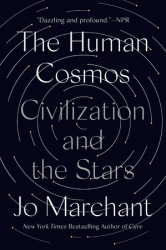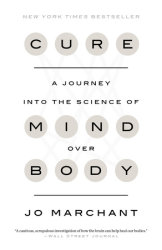To cure is Western medicine’s objective. In Cure: A Journey into the Science of Mind Over Body, journalist Jo Marchant tackles just what some of those medically-sanctioned treatments could be. You’ve heard of a lot of them already: placebos, hypnosis, strong social networks, purpose. What is less known is what exactly happens to our bodies, and our brains, when we use those treatments to treat conditions from depression to fatigue to pain.
Marchant’s Cure tells us. Packed with case studies on things like honest placebos, rubber-hand therapy, and meditation, in tandem with brain scans, patient reports, and immune systems checks, it does something else, too: Her look at when and how these cures work shows us how we work, too, adding a complex narrative to the ongoing study of what our brains and minds mean to each other.
PENGUIN RANDOM HOUSE: At its heart, your book Cure is a data-driven exploration of the world of mind-body medicine. Can you give an overview of this field?
JO MARCHANT: It’s quite a strange field because there’s such a lot of public interest in it — people have such strong feelings about it and it can be quite polarizing, some people think that the mind can cure anything, and others that there is no connection between the mind and body — but there isn’t very much public funding. It’s a quite marginal area of science.
In terms of what we understand about how the mind influences healing, until a few decades ago it wasn’t understood that there was any influence at all. That has changed. We now accept that stress, for example, has very dramatic effects on the body, and that it can have very devastating effects on the course of our lives. It can make us more susceptible to diseases, for one thing. I was interested in looking at the flip side of that: are there mental states that can therefore include health? There’s not a one-size-fits-all answer.
The mind can’t cure everything, but sometimes it can have an immediate effect on conditions like pain, fatigue, nausea.
Then there are circumstances in which it has more subtle effects. It can affect our susceptibility to disease, as one factor among many.
Then there are other circumstances where it doesn’t influence anything at all. Cholesterol levels is one example of this: if you think you’ve taken a Statin, that’s not going to affect your levels. With cancers, in general, it’s not helpful to think that your mind can heal you, you need cancer treatments.
It’s a complicated picture, there are many complex links between the mind and the body that have dramatic effects, but exactly what those effects are is going to vary from person to person and according to circumstances and that’s why it’s important to take a scientific approach and see what will work.
PRH: Placebos are generally regarded as at worst a control-group device, and at best a temporary uplift through positive thinking. But some researchers, like Ted Kaptchuk, have worked with them as a technique unto themselves. How does that work?
JM: The traditional view of placebos is…well, it’s quite a confusing term. It’s often used to describe the fact that when people received a medication that they think is a real medication they feel better even if it turns out it was actually fake. There are lots of reasons for that. Sometimes people just get better over time anyway. Perhaps people are trying to please the doctor and they just say that they feel better. But what neuroscientists over the past few decades have seen is that while that does happen, something else is happening, too. Believing we’ve taken something triggers something in the brain. There are measurable differences such as the release of endorphins, what we think of as feel-good chemicals, that opiate drugs are designed to mimic. So in someone who is responding to a placebo, you’ll see those endorphins, it’s just as real as what happens with the drug, it’s the same mechanism.
With Parkinson’s, what happens is that transmitters — dopamine — don’t get produced because of impaired neurons. When Parkinson’s patients take the placebo you see a dramatic surge of dopamine, it’s exactly the same as the chemical change that happens when you take the treatment drug.
This really changes our perception of the placebo effect. It is a biochemical mechanism. The traditional assumption is always that you have to have been fooled in order to experience a placebo effect, but in the past several years — in migraine, ADHD, depression — actually honest placebos have been used. They don’t necessarily work quite as well, but you do still see a significant benefit. Research is only just beginning in terms of understanding what that is. One theory is that if you expect it will help, then you are believing. The other is that simply receiving medical care, the attention makes people feel safe and supported and well cared for, the context can relieve symptoms.
A third possible mechanism is physiological condition. As with Pavlov’s dog, by learning through association, you come to induce a physiological function, including pain, and including the immune system. This system can reach beyond the traditional symptoms relieved by placebo. So if you take a drug a few times that has a certain response, then when you take a placebo pill that association still happens. You need to know you’re taking the pill, it won’t work if it’s administered while you’re asleep. It’s the same way if you picture biting into a lemon, you’ll automatically start salivating.
The issues with placebo is that you’d be lying to patients, but honest placebos are a way around that. In theory you should keep taking the active drug along with the placebo as it will enhance placebo responses. Finding a doctor that you like and trust can help, too. But in situations where there are significant downsides to taking drugs, side effects, or addictions, placebos can have a strong effect on conditions like chronic pain and depression, in which there is significant response to them.
PRH: You write that, “In general, religious attendance is associated with 7–14 years of additional life.” How are the effects of religiosity and spirituality different from placebo effects?
JM: I think a lot of the mechanisms are probably very similar. Placebo effects are very broad-ranging, they’re telling us about the context in which that care is administered: do we feel cared for, comfortable, and impressed by the hospital, there’s the ritual.
I think some of the mechanisms with religious belief are similar: if you’ve prayed to god to heal you and you believe that he’s going to, that can be like taking a placebo and believing it’s going to help you. And if you go to church you probably have a strong support network, you probably have a healthier lifestyle than people who don’t. It helps to ease your anxiety and concern about your condition. It makes you feel safe.
Something that religious belief gives that perhaps placebos don’t is meaning and purpose in life, that’s something extra that seems to be good for your health. There was one study for example that compared different ways of well being: eudemonic vs. hedonic. Researchers were looking at gene expression in the immune system, and those with a hedonic well-being had higher expression of the inflammation genes, while those with a eudemonic well-being had lower expressions. The study suggests that if you care about things outside yourself, it impacts your health in a positive way.
PRH:Your book covers neuroscientist Sara Lazar’s work on the effects of yoga, that she “was convinced that her yoga practice had induced not just a passing state of consciousness but a permanent shift in how her brain worked.” Can you talk about this connection between muscle-building and brain activity?
JM: She started off being interested in yoga but when she started to study this, she switched to meditation so that she could use a brain scanner, so it wasn’t so much the muscle building but the brain work associated with doing yoga.
Initially she compared experienced meditators with novices. There was more gray matter in the prefrontal cortex — rational thinking — and less in the amygdala — fear, and threat; it’s involved in phobia, and then generally your prefrontal cortex will step in a few minutes later and say, look, there’s nothing to worry about, it’s fine — in the experienced meditators. You don’t know if those are just different kinds of people, but then she looked at novices after eight weeks of practice, and again saw those changes in those people, which suggests they would be much better prepared to deal with stress. There was a reduction in size of the amygdala for the novices. In people who are very stressed, you see a reduction in the prefrontal cortex and an increase in the size of amygdala, but it is possible to reverse this.
PRH: The pain management techniques you describe are fascinating too, particularly their consideration of pain as a composite of what our body feels and our perception of how much danger we’re in. There are phantom limbs, rubber-hand illusions, and virtual reality in there, too: Can you talk about how all these things are related?
JM: I think there’s a common misconception about pain. We see it as: we damage our body, the nerves see it, send a signal to our brain and that causes pain. That isn’t really what happens. Through a lot of different lines, the work on phantom limbs, rubber-hand therapy, virtual reality, researchers are all coming to the same conclusion: when we experience things like pain, our brains are going through a sort of cost analysis, figuring out what is the appropriate level for us to feel. Our brains develop it as an alarm, to tell us something is wrong and to force us to do something. If you feel fatigue, for example, it forces you to rest, but that also has a cost: if you’re too much in pain or too tired you can’t run from a predator, so your brain is always trying to figure out the appropriate amount of pain to feel. So it’s not just those physical symptoms that are feeding into those feelings, it’s the circumstance as well. If you break your ankle, you need to feel pain and fatigue: if you feel alone, that will amplify the pain; once you feel safe and receive medical treatment, the brain reduces its defenses and the pain reduces.
It also works the other way. If you have a broken ankle, and a tiger is chasing you, then the pain will disappear completely because your brain wants you to get out of there. These therapies convince your brain that you’re in a safe, controlled, calm world, the crisis is over.
With rubber-hand and mirror therapy, there’s something slightly different going on. There’s sort of a mental map in our brain, what belongs to us and what doesn’t. Sometimes something happens to us and that map can get disrupted, for example sometimes with an amputation you feel pain in the missing part, there’s a sort of mismatch.
We have a complex regional pain system: when someone breaks their arm, for example, and the arm heals but there’s still pain. Or arthritis, where the pain is mismatched to the amount of actual damage. So in mirror therapy, where you see the healthy arm instead of the damaged arm, that requires the brain to have the healthy response instead.
It all comes down to pain having a purpose as a warning signal and if we can convince ourselves that the danger has gone then the pain will ease as well.
PRH: What role does empathy play in medical care?
JM: I see empathy as part of social support in general so if we feel listened to, cared for, supported, that is all going to help reduce the amount of anxiety and fear that we’re feeling. There are studies looking exactly at this. Ted Kaptchuk did studies on people with IBS. In one study, they all had acupuncture, the group that had acupuncture delivered by a warm-mannered doctor, did significantly better that those with a cold-mannered doctor, both groups did much better than people with IBS who had no acupuncture at all.
Or, looking at patients with acid reflux disease: in one study, all patients received a placebo, some received standard 20-minute consultations, others had a much longer consultation with the doctor asking them about their lives, how they were doing, how it was affecting them. The second group had a better response to the placebo. We’re concentrating more and more on intervention and drugs, and appointment times are getting shorter and shorter. Research suggests that these things should be taken just as seriously as the research on drugs.
PRH:You write that “Taking account of the mind in health is actually a more scientific and evidence-based approach than relying ever more heavily on physical interventions and drugs,” which I read as Cure’s purpose. Can you say a few last words about this?
JM: Science in general is based on this very reductionist world view, going back to Descartes, where measurable physical matter is seen as more real and more worthy of study than things like feelings and thoughts. In a field like medicine that is crucially important to our health, we care about living a long life but we want that to be a quality life. We need to find a scientific way of studying those things. This idea that the mind couldn’t possibly have any connection to the body doesn’t make sense: that would mean that the mind is this disconnected floating consciousness in the brain, like a spirit or a soul, and to me that doesn’t seem very scientific at all. We’ve evolved for the mind to be completely entwined with our body. For me it’s a much more scientific way of looking at things, the mind is integrated with our body and it’s there for our survival. We need to find ways of scientifically investigating how the mind affects health.













